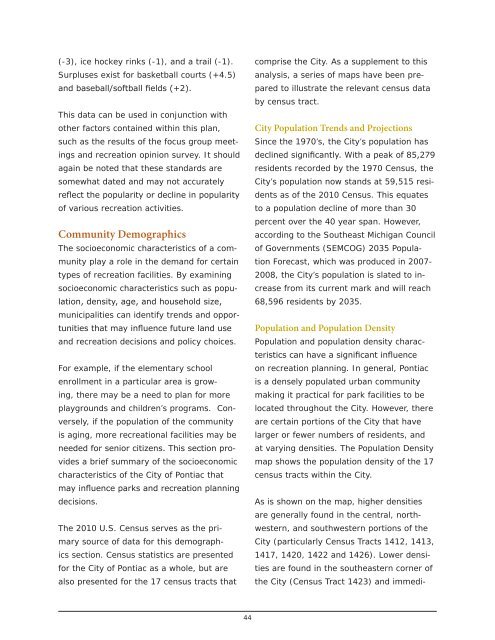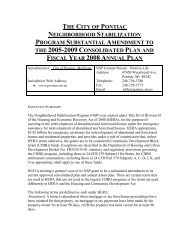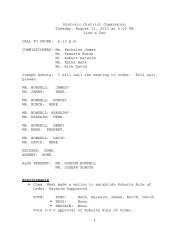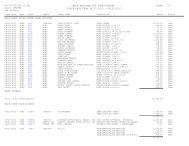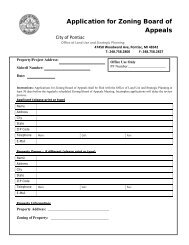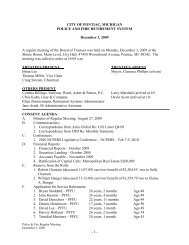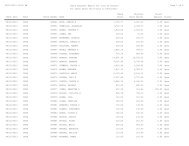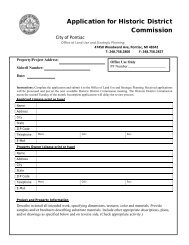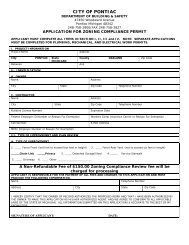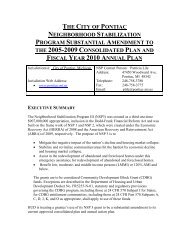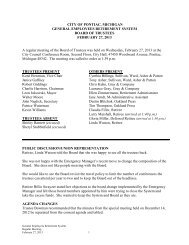City of Pontiac Parks and Recreation Master Plan
City of Pontiac Parks and Recreation Master Plan
City of Pontiac Parks and Recreation Master Plan
You also want an ePaper? Increase the reach of your titles
YUMPU automatically turns print PDFs into web optimized ePapers that Google loves.
(-3), ice hockey rinks (-1), <strong>and</strong> a trail (-1).<br />
Surpluses exist for basketball courts (+4.5)<br />
<strong>and</strong> baseball/s<strong>of</strong>tball fields (+2).<br />
This data can be used in conjunction with<br />
other factors contained within this plan,<br />
such as the results <strong>of</strong> the focus group meetings<br />
<strong>and</strong> recreation opinion survey. It should<br />
again be noted that these st<strong>and</strong>ards are<br />
somewhat dated <strong>and</strong> may not accurately<br />
reflect the popularity or decline in popularity<br />
<strong>of</strong> various recreation activities.<br />
Community Demographics<br />
The socioeconomic characteristics <strong>of</strong> a community<br />
play a role in the dem<strong>and</strong> for certain<br />
types <strong>of</strong> recreation facilities. By examining<br />
socioeconomic characteristics such as population,<br />
density, age, <strong>and</strong> household size,<br />
municipalities can identify trends <strong>and</strong> opportunities<br />
that may influence future l<strong>and</strong> use<br />
<strong>and</strong> recreation decisions <strong>and</strong> policy choices.<br />
For example, if the elementary school<br />
enrollment in a particular area is growing,<br />
there may be a need to plan for more<br />
playgrounds <strong>and</strong> children’s programs. Conversely,<br />
if the population <strong>of</strong> the community<br />
is aging, more recreational facilities may be<br />
needed for senior citizens. This section provides<br />
a brief summary <strong>of</strong> the socioeconomic<br />
characteristics <strong>of</strong> the <strong>City</strong> <strong>of</strong> <strong>Pontiac</strong> that<br />
may influence parks <strong>and</strong> recreation planning<br />
decisions.<br />
The 2010 U.S. Census serves as the primary<br />
source <strong>of</strong> data for this demographics<br />
section. Census statistics are presented<br />
for the <strong>City</strong> <strong>of</strong> <strong>Pontiac</strong> as a whole, but are<br />
also presented for the 17 census tracts that<br />
comprise the <strong>City</strong>. As a supplement to this<br />
analysis, a series <strong>of</strong> maps have been prepared<br />
to illustrate the relevant census data<br />
by census tract.<br />
<strong>City</strong> Population Trends <strong>and</strong> Projections<br />
Since the 1970’s, the <strong>City</strong>’s population has<br />
declined significantly. With a peak <strong>of</strong> 85,279<br />
residents recorded by the 1970 Census, the<br />
<strong>City</strong>’s population now st<strong>and</strong>s at 59,515 residents<br />
as <strong>of</strong> the 2010 Census. This equates<br />
to a population decline <strong>of</strong> more than 30<br />
percent over the 40 year span. However,<br />
according to the Southeast Michigan Council<br />
<strong>of</strong> Governments (SEMCOG) 2035 Population<br />
Forecast, which was produced in 2007-<br />
2008, the <strong>City</strong>’s population is slated to increase<br />
from its current mark <strong>and</strong> will reach<br />
68,596 residents by 2035.<br />
Population <strong>and</strong> Population Density<br />
Population <strong>and</strong> population density characteristics<br />
can have a significant influence<br />
on recreation planning. In general, <strong>Pontiac</strong><br />
is a densely populated urban community<br />
making it practical for park facilities to be<br />
located throughout the <strong>City</strong>. However, there<br />
are certain portions <strong>of</strong> the <strong>City</strong> that have<br />
larger or fewer numbers <strong>of</strong> residents, <strong>and</strong><br />
at varying densities. The Population Density<br />
map shows the population density <strong>of</strong> the 17<br />
census tracts within the <strong>City</strong>.<br />
As is shown on the map, higher densities<br />
are generally found in the central, northwestern,<br />
<strong>and</strong> southwestern portions <strong>of</strong> the<br />
<strong>City</strong> (particularly Census Tracts 1412, 1413,<br />
1417, 1420, 1422 <strong>and</strong> 1426). Lower densities<br />
are found in the southeastern corner <strong>of</strong><br />
the <strong>City</strong> (Census Tract 1423) <strong>and</strong> immedi-<br />
44


